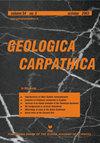Upper Neoproterozoic garnet-bearing granites in the Zeber-Kuh region from east central Iran micro plate: Implications for the magmatic evolution in the northern margin of Gondwanaland
IF 1.5
4区 地球科学
Q4 GEOSCIENCES, MULTIDISCIPLINARY
引用次数: 0
Abstract
This paper reports, for the first time, on a garnet-bearing granite body at Zeber-Kuh and interprets its petrogenesis, age and tectonic setting within the context of the evolution of the Cadomian subduction system. The primary minerals imply an origin at pressures greater than 8–6 kbars (~ 25 km depth) and at temperatures above 700 °C with >10 % water. The Zeber-Kuh granite is in tectonic contact with neighboring rocks. This igneous body has average SiO2 of 71 wt. %, average Al2O3 of 14 wt. %, 3.1–3.6 wt. % Na2O, 3.0–6.2 wt. % K2O and 3.3–0.1 wt. % MgO. The granite is characterized by light rare earth element (LREE)-enrichment, relatively flat heavy rare earth element (HREE) patterns with a small negative Eu anomaly and moderately fractioned REE patterns [average (La/Yb)N = 11.32]. Decreasing Fe2O3T, MgO, CaO, TiO2, Ba, Eu and Sr with increasing SiO2 contents are consistent with fractional crystallization and can be related to fractionation of plagioclase, clinopyroxene, hornblende, and apatite. Two granite samples yielded U–Pb zircon ages of 533±3 and 534±6 Ma, which regionally correspond to the younger Cadomian magmatism. Cathodoluminescence images of zircon grains from the studied samples show well-developed oscillatory bands, typical of felsic magmas zircons, and Th/U ratios range from 0.79 to 0.45 with an average of 0.60. The REE patterns of the zircons show progressive enrichment from LREE to HREE with a positive Ce anomaly and a negative Eu anomaly.The garnet-bearing granite of Zeber-Kuh represents the final stage of Cadomian magmatism along an extensional continental arc adjacent to the northern active margin of Gondwanaland.伊朗中东部微板块Zeber-Kuh地区上新元古代含石榴石花岗岩:对冈瓦纳大陆北缘岩浆演化的启示
本文首次报道了Zeber-Kuh地区的一个含石榴石花岗岩体,并在卡多米亚俯冲体系演化的背景下对其岩石成因、年龄和构造背景进行了解释。原生矿物的起源意味着压力大于8-6千巴(~ 25公里深),温度高于700°C,水含量为10%。Zeber-Kuh花岗岩与邻近岩石有构造接触。该火成岩的SiO2平均值为71 wt. %, Al2O3平均值为14 wt. %, Na2O平均值为3.1 ~ 3.6 wt. %, K2O平均值为3.0 ~ 6.2 wt. %, MgO平均值为3.3 ~ 0.1 wt. %。花岗岩具有轻稀土元素(LREE)富集,重稀土元素(HREE)模式相对平坦,Eu负异常较小,REE模式适中的特征[平均(La/Yb)N = 11.32]。Fe2O3T、MgO、CaO、TiO2、Ba、Eu和Sr随着SiO2含量的增加而减少,这与斜长石、斜辉石、角闪石和磷灰石的分选有关。两个花岗岩样品的U-Pb锆石年龄分别为533±3和534±6 Ma,在区域上对应于较年轻的卡多米期岩浆活动。样品的锆石阴极发光显示出发育良好的振荡带,具有典型的长英质岩浆锆石特征,Th/U比值在0.79 ~ 0.45之间,平均为0.60。锆石的REE模式表现为由LREE向HREE递进富集,Ce呈正异常,Eu呈负异常。Zeber-Kuh的含石榴石花岗岩代表了卡多米期岩浆活动的最后阶段,这条伸展大陆弧与冈瓦纳大陆北部活动边缘相邻。
本文章由计算机程序翻译,如有差异,请以英文原文为准。
求助全文
约1分钟内获得全文
求助全文
来源期刊

Geologica Carpathica
地学-地球科学综合
CiteScore
2.40
自引率
23.10%
发文量
26
审稿时长
>12 weeks
期刊介绍:
GEOLOGICA CARPATHICA covers a wide spectrum of geological disciplines including geodynamics, tectonics and structural geology, volcanology, stratigraphy, geochronology and isotopic geology, karstology, geochemistry, mineralogy, petrology, lithology and sedimentology, paleogeography, paleoecology, paleobiology and paleontology, paleomagnetism, magnetostratigraphy and other branches of applied geophysics, economic and environmental geology, experimental and theoretical geoscientific studies. Geologica Carpathica , with its 60 year old tradition, presents high-quality research papers devoted to all aspects not only of the Alpine-Carpathian-Balkanian geoscience but also with adjacent regions originated from the Mediterranean Tethys and its continental foreland. Geologica Carpathica is an Official Journal of the Carpathian-Balkan Geological Association.
 求助内容:
求助内容: 应助结果提醒方式:
应助结果提醒方式:


